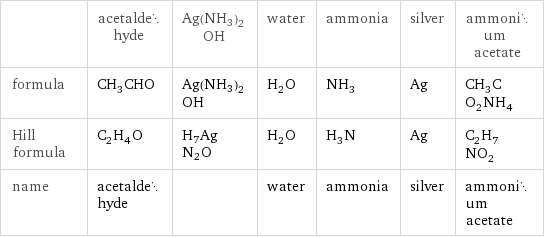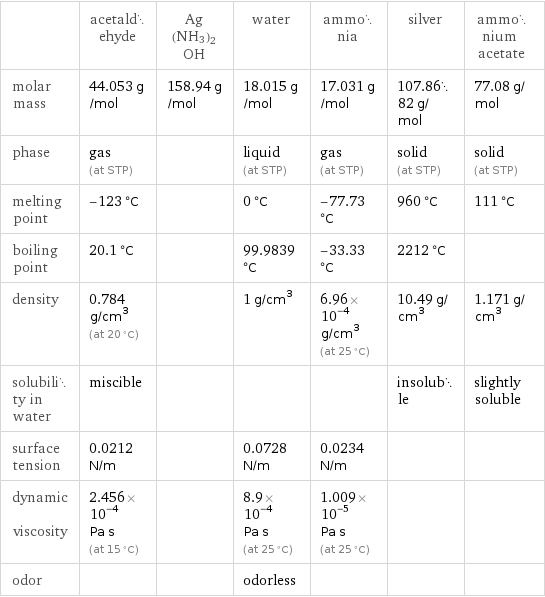Input interpretation

CH_3CHO acetaldehyde + Ag(NH3)2OH ⟶ H_2O water + NH_3 ammonia + Ag silver + CH_3CO_2NH_4 ammonium acetate
Balanced equation

Balance the chemical equation algebraically: CH_3CHO + Ag(NH3)2OH ⟶ H_2O + NH_3 + Ag + CH_3CO_2NH_4 Add stoichiometric coefficients, c_i, to the reactants and products: c_1 CH_3CHO + c_2 Ag(NH3)2OH ⟶ c_3 H_2O + c_4 NH_3 + c_5 Ag + c_6 CH_3CO_2NH_4 Set the number of atoms in the reactants equal to the number of atoms in the products for C, H, O, Ag and N: C: | 2 c_1 = 2 c_6 H: | 4 c_1 + 7 c_2 = 2 c_3 + 3 c_4 + 7 c_6 O: | c_1 + c_2 = c_3 + 2 c_6 Ag: | c_2 = c_5 N: | 2 c_2 = c_4 + c_6 Since the coefficients are relative quantities and underdetermined, choose a coefficient to set arbitrarily. To keep the coefficients small, the arbitrary value is ordinarily one. For instance, set c_1 = 1 and solve the system of equations for the remaining coefficients: c_1 = 1 c_2 = 2 c_3 = 1 c_4 = 3 c_5 = 2 c_6 = 1 Substitute the coefficients into the chemical reaction to obtain the balanced equation: Answer: | | CH_3CHO + 2 Ag(NH3)2OH ⟶ H_2O + 3 NH_3 + 2 Ag + CH_3CO_2NH_4
Structures

+ Ag(NH3)2OH ⟶ + + +
Names

acetaldehyde + Ag(NH3)2OH ⟶ water + ammonia + silver + ammonium acetate
Equilibrium constant
![Construct the equilibrium constant, K, expression for: CH_3CHO + Ag(NH3)2OH ⟶ H_2O + NH_3 + Ag + CH_3CO_2NH_4 Plan: • Balance the chemical equation. • Determine the stoichiometric numbers. • Assemble the activity expression for each chemical species. • Use the activity expressions to build the equilibrium constant expression. Write the balanced chemical equation: CH_3CHO + 2 Ag(NH3)2OH ⟶ H_2O + 3 NH_3 + 2 Ag + CH_3CO_2NH_4 Assign stoichiometric numbers, ν_i, using the stoichiometric coefficients, c_i, from the balanced chemical equation in the following manner: ν_i = -c_i for reactants and ν_i = c_i for products: chemical species | c_i | ν_i CH_3CHO | 1 | -1 Ag(NH3)2OH | 2 | -2 H_2O | 1 | 1 NH_3 | 3 | 3 Ag | 2 | 2 CH_3CO_2NH_4 | 1 | 1 Assemble the activity expressions accounting for the state of matter and ν_i: chemical species | c_i | ν_i | activity expression CH_3CHO | 1 | -1 | ([CH3CHO])^(-1) Ag(NH3)2OH | 2 | -2 | ([Ag(NH3)2OH])^(-2) H_2O | 1 | 1 | [H2O] NH_3 | 3 | 3 | ([NH3])^3 Ag | 2 | 2 | ([Ag])^2 CH_3CO_2NH_4 | 1 | 1 | [CH3CO2NH4] The equilibrium constant symbol in the concentration basis is: K_c Mulitply the activity expressions to arrive at the K_c expression: Answer: | | K_c = ([CH3CHO])^(-1) ([Ag(NH3)2OH])^(-2) [H2O] ([NH3])^3 ([Ag])^2 [CH3CO2NH4] = ([H2O] ([NH3])^3 ([Ag])^2 [CH3CO2NH4])/([CH3CHO] ([Ag(NH3)2OH])^2)](../image_source/ea672e3219209b7a1a7687d144e8b3bc.png)
Construct the equilibrium constant, K, expression for: CH_3CHO + Ag(NH3)2OH ⟶ H_2O + NH_3 + Ag + CH_3CO_2NH_4 Plan: • Balance the chemical equation. • Determine the stoichiometric numbers. • Assemble the activity expression for each chemical species. • Use the activity expressions to build the equilibrium constant expression. Write the balanced chemical equation: CH_3CHO + 2 Ag(NH3)2OH ⟶ H_2O + 3 NH_3 + 2 Ag + CH_3CO_2NH_4 Assign stoichiometric numbers, ν_i, using the stoichiometric coefficients, c_i, from the balanced chemical equation in the following manner: ν_i = -c_i for reactants and ν_i = c_i for products: chemical species | c_i | ν_i CH_3CHO | 1 | -1 Ag(NH3)2OH | 2 | -2 H_2O | 1 | 1 NH_3 | 3 | 3 Ag | 2 | 2 CH_3CO_2NH_4 | 1 | 1 Assemble the activity expressions accounting for the state of matter and ν_i: chemical species | c_i | ν_i | activity expression CH_3CHO | 1 | -1 | ([CH3CHO])^(-1) Ag(NH3)2OH | 2 | -2 | ([Ag(NH3)2OH])^(-2) H_2O | 1 | 1 | [H2O] NH_3 | 3 | 3 | ([NH3])^3 Ag | 2 | 2 | ([Ag])^2 CH_3CO_2NH_4 | 1 | 1 | [CH3CO2NH4] The equilibrium constant symbol in the concentration basis is: K_c Mulitply the activity expressions to arrive at the K_c expression: Answer: | | K_c = ([CH3CHO])^(-1) ([Ag(NH3)2OH])^(-2) [H2O] ([NH3])^3 ([Ag])^2 [CH3CO2NH4] = ([H2O] ([NH3])^3 ([Ag])^2 [CH3CO2NH4])/([CH3CHO] ([Ag(NH3)2OH])^2)
Rate of reaction
![Construct the rate of reaction expression for: CH_3CHO + Ag(NH3)2OH ⟶ H_2O + NH_3 + Ag + CH_3CO_2NH_4 Plan: • Balance the chemical equation. • Determine the stoichiometric numbers. • Assemble the rate term for each chemical species. • Write the rate of reaction expression. Write the balanced chemical equation: CH_3CHO + 2 Ag(NH3)2OH ⟶ H_2O + 3 NH_3 + 2 Ag + CH_3CO_2NH_4 Assign stoichiometric numbers, ν_i, using the stoichiometric coefficients, c_i, from the balanced chemical equation in the following manner: ν_i = -c_i for reactants and ν_i = c_i for products: chemical species | c_i | ν_i CH_3CHO | 1 | -1 Ag(NH3)2OH | 2 | -2 H_2O | 1 | 1 NH_3 | 3 | 3 Ag | 2 | 2 CH_3CO_2NH_4 | 1 | 1 The rate term for each chemical species, B_i, is 1/ν_i(Δ[B_i])/(Δt) where [B_i] is the amount concentration and t is time: chemical species | c_i | ν_i | rate term CH_3CHO | 1 | -1 | -(Δ[CH3CHO])/(Δt) Ag(NH3)2OH | 2 | -2 | -1/2 (Δ[Ag(NH3)2OH])/(Δt) H_2O | 1 | 1 | (Δ[H2O])/(Δt) NH_3 | 3 | 3 | 1/3 (Δ[NH3])/(Δt) Ag | 2 | 2 | 1/2 (Δ[Ag])/(Δt) CH_3CO_2NH_4 | 1 | 1 | (Δ[CH3CO2NH4])/(Δt) (for infinitesimal rate of change, replace Δ with d) Set the rate terms equal to each other to arrive at the rate expression: Answer: | | rate = -(Δ[CH3CHO])/(Δt) = -1/2 (Δ[Ag(NH3)2OH])/(Δt) = (Δ[H2O])/(Δt) = 1/3 (Δ[NH3])/(Δt) = 1/2 (Δ[Ag])/(Δt) = (Δ[CH3CO2NH4])/(Δt) (assuming constant volume and no accumulation of intermediates or side products)](../image_source/5b8745b33487fce5ba15d7faa057443c.png)
Construct the rate of reaction expression for: CH_3CHO + Ag(NH3)2OH ⟶ H_2O + NH_3 + Ag + CH_3CO_2NH_4 Plan: • Balance the chemical equation. • Determine the stoichiometric numbers. • Assemble the rate term for each chemical species. • Write the rate of reaction expression. Write the balanced chemical equation: CH_3CHO + 2 Ag(NH3)2OH ⟶ H_2O + 3 NH_3 + 2 Ag + CH_3CO_2NH_4 Assign stoichiometric numbers, ν_i, using the stoichiometric coefficients, c_i, from the balanced chemical equation in the following manner: ν_i = -c_i for reactants and ν_i = c_i for products: chemical species | c_i | ν_i CH_3CHO | 1 | -1 Ag(NH3)2OH | 2 | -2 H_2O | 1 | 1 NH_3 | 3 | 3 Ag | 2 | 2 CH_3CO_2NH_4 | 1 | 1 The rate term for each chemical species, B_i, is 1/ν_i(Δ[B_i])/(Δt) where [B_i] is the amount concentration and t is time: chemical species | c_i | ν_i | rate term CH_3CHO | 1 | -1 | -(Δ[CH3CHO])/(Δt) Ag(NH3)2OH | 2 | -2 | -1/2 (Δ[Ag(NH3)2OH])/(Δt) H_2O | 1 | 1 | (Δ[H2O])/(Δt) NH_3 | 3 | 3 | 1/3 (Δ[NH3])/(Δt) Ag | 2 | 2 | 1/2 (Δ[Ag])/(Δt) CH_3CO_2NH_4 | 1 | 1 | (Δ[CH3CO2NH4])/(Δt) (for infinitesimal rate of change, replace Δ with d) Set the rate terms equal to each other to arrive at the rate expression: Answer: | | rate = -(Δ[CH3CHO])/(Δt) = -1/2 (Δ[Ag(NH3)2OH])/(Δt) = (Δ[H2O])/(Δt) = 1/3 (Δ[NH3])/(Δt) = 1/2 (Δ[Ag])/(Δt) = (Δ[CH3CO2NH4])/(Δt) (assuming constant volume and no accumulation of intermediates or side products)
Chemical names and formulas

| acetaldehyde | Ag(NH3)2OH | water | ammonia | silver | ammonium acetate formula | CH_3CHO | Ag(NH3)2OH | H_2O | NH_3 | Ag | CH_3CO_2NH_4 Hill formula | C_2H_4O | H7AgN2O | H_2O | H_3N | Ag | C_2H_7NO_2 name | acetaldehyde | | water | ammonia | silver | ammonium acetate
Substance properties

| acetaldehyde | Ag(NH3)2OH | water | ammonia | silver | ammonium acetate molar mass | 44.053 g/mol | 158.94 g/mol | 18.015 g/mol | 17.031 g/mol | 107.8682 g/mol | 77.08 g/mol phase | gas (at STP) | | liquid (at STP) | gas (at STP) | solid (at STP) | solid (at STP) melting point | -123 °C | | 0 °C | -77.73 °C | 960 °C | 111 °C boiling point | 20.1 °C | | 99.9839 °C | -33.33 °C | 2212 °C | density | 0.784 g/cm^3 (at 20 °C) | | 1 g/cm^3 | 6.96×10^-4 g/cm^3 (at 25 °C) | 10.49 g/cm^3 | 1.171 g/cm^3 solubility in water | miscible | | | | insoluble | slightly soluble surface tension | 0.0212 N/m | | 0.0728 N/m | 0.0234 N/m | | dynamic viscosity | 2.456×10^-4 Pa s (at 15 °C) | | 8.9×10^-4 Pa s (at 25 °C) | 1.009×10^-5 Pa s (at 25 °C) | | odor | | | odorless | | |
Units
